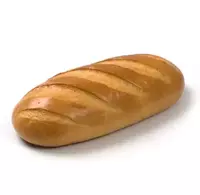Long loaf

Loaf, the famous bakery product, got its name thanks to the French word bâton, which means stick or bar. Such an analogy was not drawn. The fact is that the first loaves began to be made, like a baguette, in a long, oblong and thin shape. A little later, the loaf "became stale" and acquired its modern appearance. Moreover, in the Middle Ages in France, gingerbread called loaf was baked from a cool dough, often adding honey, nuts or dried fruits.
Currently, the loaf is called improved white bread, which has an oblong shape. Remarkably, the term loaf is used to refer to elongated sausages, such as a stick or sausage loaf. There are several main criteria by which this bakery product is classified and a particular variety and type of loaf is assigned.
There is a distinction between the set of ingredients that are part of the loaf, for example, the variety and type of flour are taken into account. Raisins or dried apricots are often added to loaves. Such loaves are sweet and pleasant to taste, their dough is airy and resembles a pillowy bun. Freshly baked raisin loaves with a crisp crust can be a lovely treat for family tea parties.
There are also city, student, Moscow region, capital, special and table loaves. The latter, by the way, are considered the most caloric. Batons differ in their size, products weighing 300, 400-450 and 500 grams are found, 18 to 70 cm long, and 5 to 13 cm wide. Baton can be sliced and packed. There are shape-specific types of loaves. For example, loaves with rounded or sharp ends.
Baton composition
The taste and calorie content of the loaf depends on the composition of the ingredients of the product. Often, different recipes suggest using from 5 to 50 grams of sugar per kilogram of flour in a dough for loaves. This is a fairly large scattering, which determines the calorie content of the loaf, as well as its appearance. There are sweet, fresh, salty loaves.
Usually, the loaf includes prime, first and second grade wheat flour, salt, vegetable oil or margarine, sugar, water and yeast. You can easily make a loaf at home. However, this will require either a universal bakery or a special mode for baking bakery products in an oven.
Almost all species of loaf have longitudinal incisions on their surface. This pattern makes the bakery product unique and easy to remember. Batons, which are produced in the food industry before baking, are greased with a special solution that gives shine to the crust of baked bread.
The quality of batons is assessed according to the following parameters: the shape of the product (there should be no deformations), the color of the baton surface, as well as the crumb. In laboratory conditions, the loaf is tested as a food product for acidity, humidity, porosity, as well as detecting the content of preservatives, food additives and taste enhancers in the chemical composition of the product, if any.
baton 262 kCal
The energy value of the loaf (Ratio of proteins, fats, carbohydrates - ju):
Proteins: 7.5 g (~ 30 kCal)
Fats: 2.9 g (~ 26 kCal)
Carbohydrates: 51.4 g (~ 206 kCal)
Energy ratio (bj | y): 11% | 10% | 78%
 Español
Español Français
Français Português
Português Русский
Русский 简体中文
简体中文 繁體中文
繁體中文 日本語
日本語 한국어
한국어 العربية
العربية Türkçe
Türkçe Қазақ
Қазақ Deutsch
Deutsch Italiano
Italiano Українська
Українська
